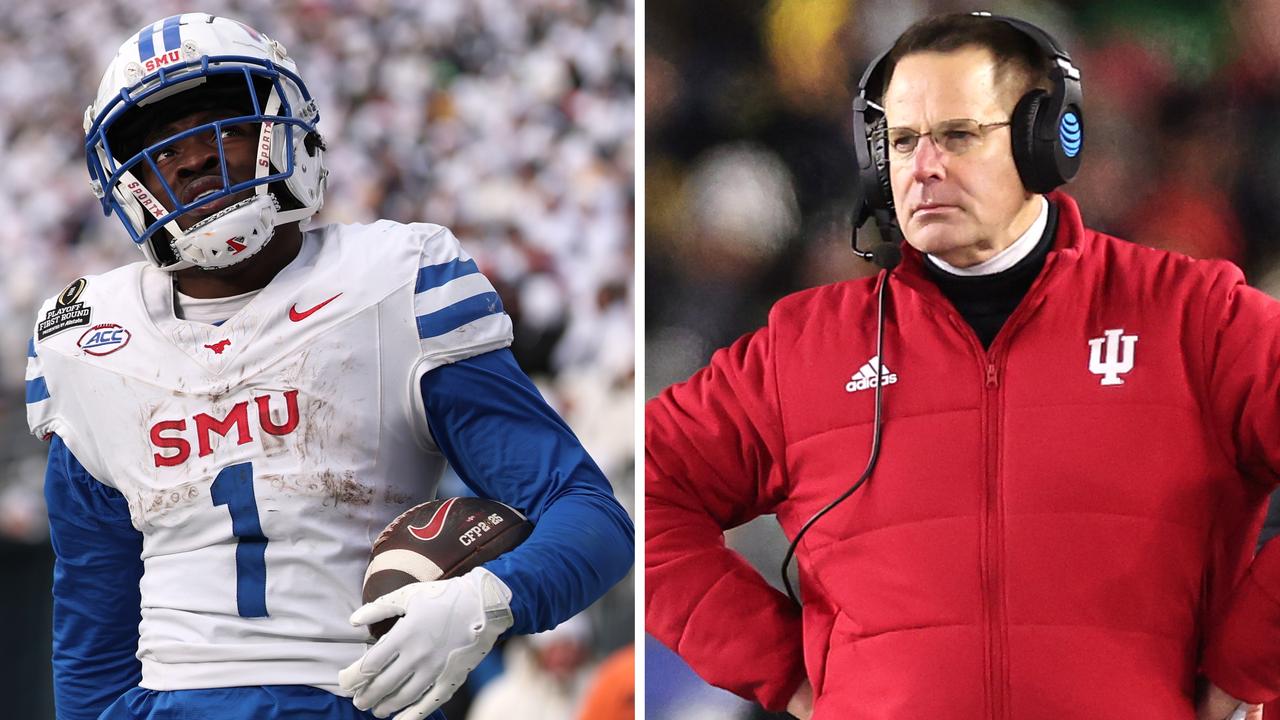America’s second-biggest sport has been broken for over a century. Until this weekend.
Watch an average of 6 games each week during the regular season, plus every game of the NFL Postseason including the Super Bowl, plus the College Football Playoff LIVE on ESPN with Kayo. New to Kayo? Get your first month for just $1. Limited time offer.
That’s when the top level of college football finally held a truly inclusive playoff, allowing 12 teams into the post-season – after a decade of a minimalist four-team bracket, and many years before that of polls deciding who played for, or even won, the national championship.
But the reaction to the first round of the 12-team College Football Playoff can be best summed up as mindless. Perhaps even stupid.
Admittedly, most people were hoping for a more competitive weekend of games. The first game was the closest, with No.7 seed Notre Dame beating No.10 Indiana 27-17 – in a scoreline that wasn’t at all reflective of how the game felt. Notre Dame was dominant.
So too were No.6 Penn State (38-10 over No.11 SMU), No.5 Texas (38-24 over No.12 Clemson) and most surprisingly No.8 Ohio State (42-17 over No.9 Tennessee).
Based on the seedings, and the fact Tennessee plays in the highly-rated Southeastern Conference (SEC), most assumed their game would be the closest, or at least the best chance of an upset.
Instead the Buckeyes, still sore from their staggering late-season loss to arch-rivals Michigan which cost them a spot in the Big Ten championship game, jumped out to a 21-0 lead after a quarter and never looked back.
It was certainly disappointing to have a series of effective blowouts, and the reaction from many fans and experts has been savage.
Most notably there was criticism over the fact surprise packets like Indiana, a perennial struggler who produced a stunning 11-1 season in one of the toughest conferences in the country, and SMU, a newcomer to the power conference ranks who lost their conference on a last-second field goal but backed into the post-season off the back of an 11-1 campaign, were picked at all.
The assumption seems to be that teams from the SEC who were left out, like Alabama, Ole Miss and South Carolina, would have fared better. And perhaps they would have.
Ole Miss’ coach Lane Kiffin – always happy to hop on social media – tweeted sarcastically across the weekend, first criticising the Indiana loss as a “Really exciting competitive game. Great job!!”, before quipping after SMU’s defeat “Way to keep us on the edge of our seats (CFP selection) Committee …. Riveting”.
Of course he is biased, but the real problem is that the SEC teams who missed out simply lost too many games, all finishing 9-3.
Now, going 9-3 in a tougher conference is more respectable than going 9-3 elsewhere, but they still lost games they absolutely shouldn’t have.
Alabama, the highest-ranked team of the trio, lost to conference doormat Vanderbilt and newcomer Oklahoma in the midst of their worst season in decades.
Kiffin’s Ole Miss didn’t have an excuse either, losing at home to a terrible Kentucky team, and then despite dropping another game still controlling their destiny as they sat No.9 in the nation with two weeks left – before losing to a Florida side that would’ve sacked its coach earlier in the season if they weren’t a complete mess behind the scenes.
Meanwhile South Carolina lost to the other teams in the trio early in the year, sitting at an overall record of 2-3 at one stage, and while a late charge got them in the conversation it was always hard to push them into the playoff field just based on head-to-head results.
You can’t purely rank teams based on win-loss record because some results clearly mean more than others, but particularly in the cases of Alabama and Ole Miss, the claim they wouldn’t have suffered an embarrassing playoff loss like Indiana or SMU did is preposterous… because they suffered embarrassing losses during the season to much worse teams!
The fact that Tennessee, another SEC school who made it into the lower half of the bracket because it only lost two games, got embarrassed by Ohio State sums things up.
We could say something about it proving the SEC isn’t actually that good… or it could just be one game where the better team won, like in the others!
Bizarrely, instead of celebrating giving more teams the chance to win the championship – it’s the first time most teams come into any season with a real shot at competing for the title, rather than the closed-door system which meant the same dozen blue-bloods usually traded it around – America has spent the weekend tearing down the system.
The point of the system isn’t actually to see the No.12 seed win the championship. That may never happen, but the point is that they have the chance for once… and hey, if they pull an upset or two, that’s fun!
The four-team playoff, which ran for about a decade, was legitimised in its first year when No.4 seed Ohio State won the national title. But Ohio State is one of the biggest powerhouses in the sport – it wasn’t some Cinderella run.
It was a sign that only allowing two teams into the big dance was stupid. Most years there would be huge drama over which two teams made the national title game, because three, four or more had a case. They created opportunity by creating the playoff, but it was still too limited because of the ingrained assumptions that only big teams could truly compete at the top end.
In 2021, Cincinnati – a smaller school in a smaller conference – snuck into the final four and made history. They lost, but it was the first time someone outside the big dogs even had the chance to prove they could hang with them.
And everything had to go right, with Cincinnati going unbeaten while having the right resume (thanks to a big win outside of its conference schedule) as other contenders fell over to earn that spot.
The 12-team playoff means that yes, a few teams that are never realistically going to win three or four games against the best of the best will get into the post-season, but that is completely fine. Every sport has finalists who are nowhere near as good as the true title contenders, and the rare times you get those fairytale runs to an unlikely championship are celebrated for years to come.
And this weekend’s overreaction shows US sports fans also have a very short memory. After all, there were plenty of blowouts in the four-team playoff system too – the very first game played was Oregon smashing Florida State 59-20, and that Oregon team got smashed in the national title game anyway.
Heck, powerhouses have copped embarrassing losses over the years – Ohio State losing 31-0 to Clemson in 2016, Notre Dame getting belted multiple times, and even No.1 seed Alabama losing the 2018 title game 44-16. Nobody came out of those games saying those teams didn’t deserve a spot in the playoff because that would’ve been moronic.
As college football writer Alex Kirshner shared on Bluesky: “the biggest goobers this weekend are the ones who are implying that most college football games are competitive or that the four-team semi-finals were often close.
“Most games in this sport kinda suck! That’s why the handful of close upsets are remembered more than any NFL regular season games.”
College football is defined by its haves and have nots. Technically the Ohio States and Alabamas of the world, who are some of the biggest brands in US sport period, are in the same division as tiny private schools like Tulsa (total enrolment under 4000) and even the Army, Navy and Air Force academies. It’s preposterous to compare them but it’s a preposterous sport, too big to work properly yet beautiful in its mess.
Even on ESPN’s pre-game show heading into the three Saturday (US time) playoff games, they spent a lengthy segment debating whether Indiana should’ve made the playoff at all. It’s utterly bizarre – a sport that wants to tear itself down at one of its greatest moments; a sport that complains constantly about inequality yet shuts the door immediately once any potential newcomer shows a sign of weakness because well, obviously, The Bigger Brands Must Be Better.
The playoff committee, much despised because of its perceived mistakes, has usually gotten things right. Last year, when an unbeaten conference champion Florida State was left out because its quarterback got injured at the end of the season, was the only obvious blunder; and there’ve been plenty of times when non-power conference teams were ranked lower than they should’ve been, both across the course of the season and in the final rankings.
But it’s also an impossible task to measure 130-odd teams, who play completely different schedules and only in certain circumstances overlap, while balancing the need to rank the ‘best’ teams and the ‘most deserving’ teams.
There’s a difference between those two terms. ‘Best’ implies a value judgement regardless of a team’s actual performance – like saying 9-3 Alabama should be in the playoff over 11-1 Indiana because you think Alabama would’ve beaten them if they played. Well, maybe, but we can’t know that… and we can’t decide post-season qualification based on hypotheticals.
It’s all well and good to rank teams regardless of win-loss record if you’re in the media (we do it every week during the AFL season), but to actually determine who can win a championship based on perception is naturally unfair. Indiana can’t become more historically successful than Alabama over the course of one year!
But that’s what college football has been for decades, and the 12-team playoff is the best shot of at least balancing that out a little bit.





































Discussion about this post